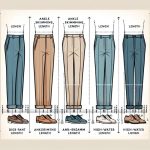When it comes to measuring the waistline of pants, it's like finding the key to a perfect fit. Have you ever wondered how to get it just right?
Let's uncover the mystery behind accurately measuring your waistline for pants. From choosing the right tools to avoiding common mistakes, I'll guide you through the steps to make sure your pants fit comfortably and flatter your figure.
So, are you ready to reveal the secrets to a well-fitting waistline?
Table of Contents
Key Takeaways
- Proper waistline measurements ensure comfortable and flattering pant fit.
- Use a flexible measuring tape for accurate and consistent measurements.
- Avoid common mistakes to prevent buying ill-fitting pants.
- Accurate waistline measurements save time and money on alterations.
Importance of Proper Waistline Measurements
Taking the correct waistline measurements for your pants is essential for ensuring a comfortable and flattering fit. Fit consistency is key; accurate measurements guarantee that your pants will fit well every time you purchase a new pair. When your pants fit properly, you feel more confident and at ease in any situation.
Moreover, correct waistline measurements help minimize the need for clothing alterations. When you know your exact waist size, you can select pants that require minimal adjustments, saving time and money. Proper measurements also reduce the chances of buying ill-fitting pants that would need extensive alterations to look right on you.
Tools Needed for Measuring Waistline
To measure your waistline accurately, all you need is a flexible measuring tape. Having the right tools is essential for precise clothing alterations and tailoring techniques. A flexible measuring tape allows you to easily wrap it around your waist, ensuring an accurate measurement. This tool is commonly used in the fashion industry and by individuals who frequently alter or tailor clothing to fit perfectly.
Using a measuring tape designed for tailoring ensures that your waistline measurements are correct, which is pivotal for achieving the desired fit when working on clothing alterations. The flexibility of the tape allows you to easily maneuver around curves and angles, such as your natural waistline, providing an exact measurement for tailoring techniques. By having a reliable measuring tape on hand, you can confidently take precise waistline measurements for any clothing alterations or tailoring projects you undertake.
Step-by-Step Guide to Measuring Waistline
Begin by grabbing your flexible measuring tape and locating a flat surface to stand on for accurate measurements. To measure your waistline correctly, follow these steps:
- Wrap the Tape: Start by wrapping the measuring tape around your natural waistline, where your torso is narrowest. Make sure the tape is snug but not too tight.
- Read the Measurement: Look straight ahead in the mirror and make sure the tape is parallel to the floor. Take note of the measurement where the tape meets.
- Repeat for Accuracy: For sizing accuracy, it's good to take multiple measurements to make sure consistency. If you get different numbers, measure a few times to find the average.
Tips for Accurate Waistline Measurements
For accurate waistline measurements, make sure the measuring tape is snug around your narrowest torso point without being too tight. This guarantees precision in determining the correct size. Here are some tips to help you achieve accurate measurements:
| Tips for Accurate Waistline Measurements | |
|---|---|
| 1. Belt Sizing | |
| When measuring your waistline for pants, consider the size of the belt you usually wear with them. This will help guarantee a comfortable fit when you wear the pants. | |
| 2. Tailoring Adjustments | |
| If you often require tailoring adjustments on your pants, it is crucial to measure your waistline accurately. This will help the tailor make the necessary alterations for a perfect fit. | |
| 3. Consistency is Key | |
| Measure your waistline at the same point every time. Consistent measurements prevent discrepancies and help you choose pants that fit well each time you shop. | |
Common Mistakes to Avoid When Measuring
When measuring the waistline of pants, it's important to avoid common mistakes that could lead to inaccurate results.
Let's go over the measurement techniques and troubleshoot any issues that might arise.
Measurement Techniques Overview
To guarantee accurate measurements when determining waistline size for pants, it's crucial to avoid common mistakes that could lead to inaccuracies. When measuring the waistline, consider the variations in waist sizes and the challenges they present. Make sure you understand how different waistline fits can affect the overall customization options available for the pants.
Here are some key points to keep in mind:
- Avoid Guessing: Guessing measurements can result in ill-fitting pants.
- Use a Flexible Tape Measure: Using a rigid tape measure can lead to incorrect readings.
- Measure at the Natural Waistline: Measuring too high or too low can impact the fit of the pants.
Troubleshooting Inaccurate Measurements
Avoiding common mistakes is key to troubleshooting inaccurate measurements when measuring the waistline of pants accurately. When troubleshooting fit issues, make sure that the measuring tape is parallel to the ground and not twisted around the body. Double-check that the tape is snug against the waist without being too tight or too loose.
If the measurements seem off, remeasure to confirm accuracy. Adjusting the waistline for comfort can also help in achieving a better fit. Consider the type of pants and their intended use when deciding on the desired snugness around the waist. Remember, a comfortable waistline measurement is vital for both style and ease of movement.
Understanding Waistline Measurements and Sizing
Understanding waistline measurements and sizing is essential for finding the perfect fit in pants. When it comes to pants, knowing your waistline measurements and understanding sizing variations can make a significant difference in how your bottoms fit.
Here are a few key points to take note of:
- Sizing Variations: Different brands and styles may have variations in sizing, so it's important to refer to the specific size chart for each pair of pants you're considering.
- Fit Adjustments: Sometimes, even if you know your waistline measurement and the correct size, adjustments might be needed for the perfect fit. This could include alterations by a tailor or opting for pants with adjustable features like drawstrings or elastic waistbands.
- Trial and Error: Finding the right fit often involves some trial and error. Don't get discouraged if the first pair you try doesn't fit perfectly; keep experimenting with different sizes and styles until you find what works best for you.
Frequently Asked Questions
Can Waistline Measurements Vary Between Different Brands or Types of Pants?
Waistline measurements can indeed vary between brands or pants types due to brand differences in sizing and fabric variations. Checking each brand's sizing chart for accuracy before purchasing is crucial to guarantee a proper fit.
How Do You Adjust for Stretchy or Elastic Waistbands When Measuring the Waistline?
When dealing with elastic waistbands, I guarantee accuracy by gently stretching the fabric before measuring. This adjustment accounts for the stretchy nature of the material, providing a more precise waistline measurement for a better fit.
Is It Necessary to Measure the Waistline of Pants When Buying Online?
When buying online, measuring the waistline of pants is important for sizing accuracy. Different brands vary in fit consistency, so taking measurements guarantees a better fit. It's worth the effort to avoid return hassles.
Are There Any Specific Techniques for Measuring the Waistline of High-Waisted Pants Vs Low-Waisted Pants?
When measuring waistlines of high-waisted vs low-waisted pants, differences in fit are important. Techniques vary for each style, impacting accuracy levels. Make sure a snug measurement at the natural waist for high-waisted, and at the hips for low-waisted.
How Do You Account for Weight Fluctuations When Determining Waistline Measurements for Pants?
When accounting for weight fluctuations in determining waistline measurements for pants, accuracy is key. I adjust my measuring techniques based on changes in my body, ensuring a proper fit regardless of shifts in weight.
- Why Is Red Velvet Not Red? - April 25, 2024
- How Do You Describe Velvet Fabric? - April 25, 2024
- How Strong Is Velvet? - April 25, 2024






